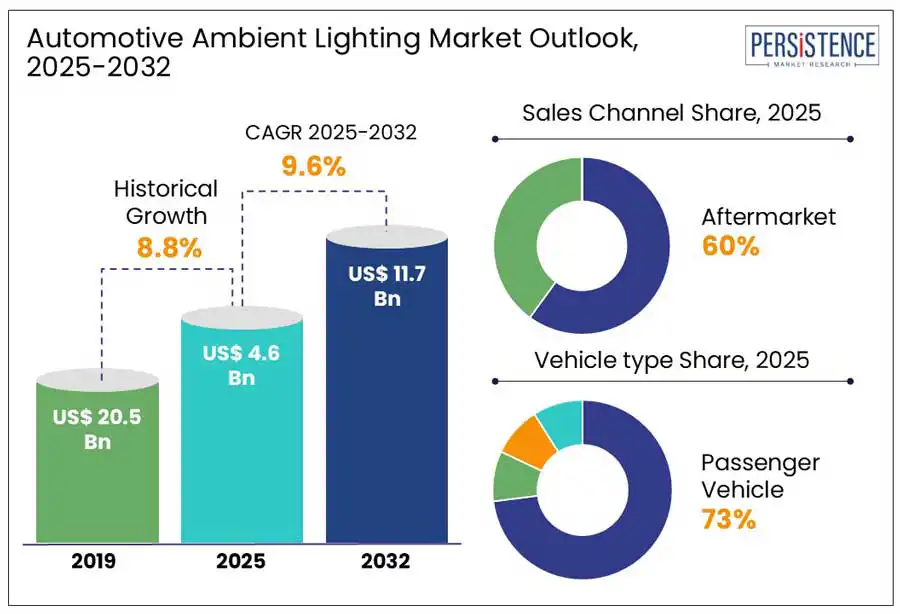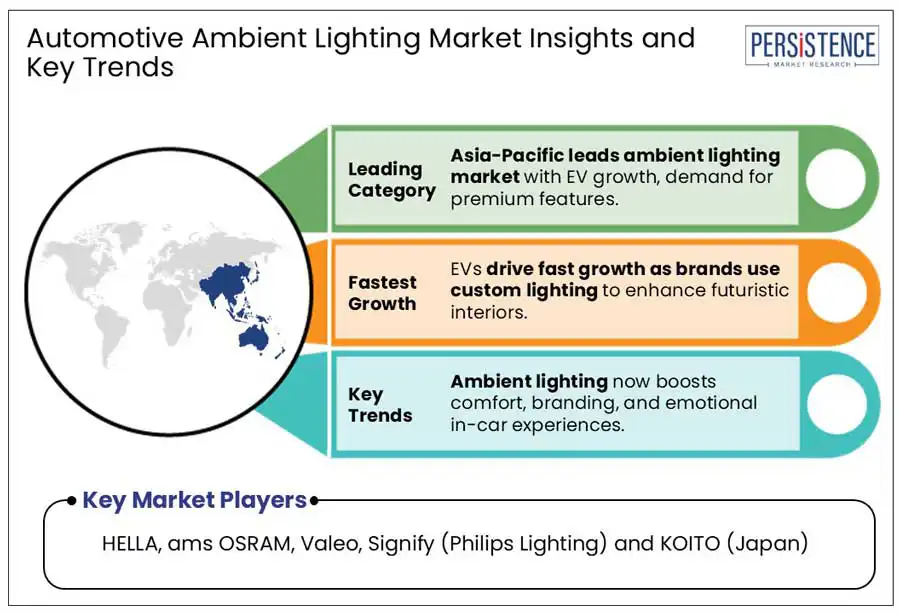Analytical Snapshot of Automotive Ambient Lighting Market Report Including Regional and Country Analysis in Brief
Industry: Automotive & Transportation
Published Date: April-2025
Format: PPT*, PDF, EXCEL
Delivery Timelines: Contact Sales
Number of Pages: 130
Report ID: PMRREP35214
The Global Automotive Ambient Lighting Market is set to grow with a whopping CAGR of 9.6% till 2032. The market size will grow from US$ 4.6 Bn in 2025 to US$ 11.7 Bn by 2032.
The latest study from Persistence Market Research reveals that the growing demand for premium and luxury vehicles, coupled with advancements in automotive lighting technology, is driving the Automotive Ambient Lighting Market. As automotive manufacturers strive to enhance in-car aesthetics, comfort, and user experience, the adoption of ambient lighting solutions is gaining momentum. For instance, Valeo's Mood Light technology enhances safety by synchronizing interior lighting with Advanced Driver-Assistance Systems (ADAS), providing real-time visual alerts for drivers. BMW has integrated dynamic ambient lighting in its iX and 7 Series models, offering customizable interior lighting schemes that adjust based on driving modes and user preferences.

Key Industry Highlights:
|
Global Market Attribute |
Key Insights |
|
Automotive Ambient Lighting Market Size (2025E) |
US$ 4.6 Bn |
|
Market Value Forecast (2032F) |
US$ 11.7 Bn |
|
Projected Growth (CAGR 2025 to 2032) |
9.6% |
|
Historical Market Growth (CAGR 2019 to 2024) |
8.4% |
Automotive interior lighting was once focused mainly on functionality, helping drivers and passengers see clearly and navigate the cabin. However, as demand has evolved, automakers are now placing equal importance on lighting that enhances the vehicle's ambiance, comfort, and emotional appeal. Today’s interior lighting is designed not just for visibility, but to reflect the driver's mood and preferences through customizable options. This shift is gaining momentum, especially with the rise of autonomous driving, where the in-car experience becomes even more central.
For instance, in 2021, Mercedes introduced the new S-Class with a 64-color ambient lighting system that enhances aesthetics and supports driver assistance functions. The lighting responds to voice commands, seatbelt reminders, and collision warnings, blending functionality with luxury. Launched in 2022, the fully electric BMW iX features ambient lighting integrated with the “Shy Tech” design philosophy. The lighting adapts to drive modes and includes illuminated crystal control surfaces, creating a futuristic cabin experience.
Vehicle manufacturers generally offer ambient lighting features in the higher-end variants segment cars, and almost all luxury vehicles. These features add to the premiumization of a car's interior with mood-enhancing effects and a couple of personalization options. However, they are typically reserved for mid to high-end models, reflecting their position as luxury upgrades rather than standard equipment. As a result, customers exclusively purchasing higher trims have access to ambient lighting, limiting its availability in mass-market models.
The price gap between models with and without ambient lighting is often significant. OEMs such as Daimler, BMW, Ford, Volkswagen, and Hyundai charge an additional cost for including ambient lighting, which helps differentiate their premium vehicles. While this creates exclusivity it also raises the overall vehicle price. This added cost may discourage price-sensitive consumers, limiting the broader adoption and growth of ambient lighting in the automotive market.
Car companies (OEMs) and lighting system manufacturers are working together to create better and more advanced lighting for vehicles. For example, ams Osram teamed up with BMW to develop high-tech laser headlights for the BMW 7 Series.
Even though smaller, local lighting companies may not be as skilled at making new technology, car makers can still work with them to produce large numbers of lighting systems for popular car models, helping to save money.
These partnerships benefit both sides. Car makers get modern, custom lighting that fits their design needs, while lighting companies get the chance to use the latest technology in their products. Plus, since they share research and development costs, both save money during the process.

Asia Pacific is set to dominate, driven by its strong automotive manufacturing base, rising consumer demand for premium vehicle features, and the rapid adoption of electric vehicles. Countries such as China, Japan, and South Korea lead the global automotive production and innovation, making them key markets for ambient lighting solutions.
With increasing consumer preference for personalized and technologically advanced interiors, the demand for customizable ambient lighting in vehicles is surging. For example, China is the world’s largest automobile producer, accounting for nearly 30% of global vehicle production in 2024. The country also dominates electric vehicle production, holding 78% of global EV battery manufacturing driving demand for energy-efficient ambient lighting solutions in modern EVs. Japan and South Korea are home to major automotive giants such as Toyota, Honda, Hyundai, and Kia which are increasingly incorporating smart ambient lighting technologies in their latest vehicle model preferences.
North America is at the forefront of innovation in automotive ambient lighting technologies. Leading companies are pioneering advancements in smart lighting solutions, integrating AI, IoT, and energy-efficient LEDs to enhance vehicle interiors. These companies collaborate with automakers, research institutions, and technology firms to develop adaptive ambient lighting systems that improve safety, personalization, and in-car user experience. Intelligent lighting synchronized with ADAS, driver monitoring systems, and voice-controlled interfaces is becoming a key differentiator in modern vehicles.
With the growing demand for customizable and dynamic ambient lighting, North America is setting the benchmark for next-generation automotive lighting solutions. North America is emerging as a leader in next-generation automotive ambient lighting, driven by increasing consumer demand for customizable and dynamic in-car experiences.
Automakers in the region are integrating multi-color LED systems, responsive lighting effects, and voice-controlled features to enhance comfort and aesthetics. The popularity of premium vehicles and electric models, especially in the U.S., is fueling adoption. Leading manufacturers such as Ford and General Motors are investing in advanced lighting technologies, while tech-focused consumers seek personalized, and mood-enhancing interiors.
Europe stands as a mature and technologically advanced market for automotive ambient lighting, led by the presence of global automotive giants such as BMW AG, Audi AG, and Mercedes-Benz Group AG. These manufacturers have integrated ambient lighting as a standard or premium feature across their luxury models.
For instance, Mercedes-Benz offers up to 64-color ambient lighting in its flagship models such as the S-Class and EQS, where lighting is linked to climate control, driving modes, and safety alerts. BMW features systems like the “Welcome Light Carpet” in models such as the 7 Series and iX, while Audi provides customizable multi-zone ambient lighting in the Q8 and A6. These offerings are designed not only to enhance interior aesthetics but also to improve user experience and cabin personalization, reflecting European consumers' high expectations for comfort, luxury, and innovation.
Europe’s focus on design excellence and safety drives ambient lighting adoption through both consumer demand and regulatory influence. Premium brands like Porsche integrate ambient lighting with drive modes and infotainment systems in models like the Taycan, while Volvo leverages minimalist ambient lighting designs in EVs like the EX90 to reflect its Scandinavian design ethos.
The global automotive ambient lighting market is highly competitive, with both regional and global players competing based on technology, pricing, and market reach. Leading manufacturers continuously invest in R&D and innovation, enhancing lighting efficiency, customization, and integration with smart vehicle systems to offer greater value to consumers.
The push for intelligent, energy-efficient, and adaptive ambient lighting has led to breakthroughs in OLED, Micro-LED, and AI-driven lighting systems. Automakers and suppliers that pioneer these technologies gain a competitive edge, setting new benchmarks for personalized and interactive in-car experiences.
New entrants include both start-ups and established automotive lighting manufacturers. Start-ups focus on securing government funding and forming partnerships with automakers to expand their footprint and develop innovative lighting solutions. Meanwhile, established players such as OSRAM, HELLA, Valeo, and Marelli leverage their strong supply chains to maintain market leadership.
|
Report Attribute |
Details |
|
Historical Data/Actuals |
2019 - 2024 |
|
Forecast Period |
2025 - 2032 |
|
Market Analysis Units |
Value: US$ Bn, Volume: As applicable |
|
Geographical Coverage |
|
|
Segmental Coverage |
|
|
Competitive Analysis |
|
|
Report Highlights |
|
|
Customization and Pricing |
Available upon request |
By Sales Channel
By Component
By Vehicle Type
By Region
To know more about delivery timeline for this report Contact Sales

The Automotive Ambient Lighting market is estimated to be valued at US$ 4.6 Bn in 2025.
Growing consumer preference for personalized, smart, and energy-efficient in-car lighting solutions, especially in electric and luxury vehicles is the key demand driver for Automotive Ambient Lighting market.
In 2025, Asia pacific dominates with ~30% share in the global Automotive Ambient Lighting market.
The demand from Aftermarket segment is expected to grow rapidly at 11.5% CAGR from 2025-2032.
The global ambient lighting market is dominated by major players such as HELLA, ams OSRAM, Valeo, Signify (Philips Lighting), and KOITO. These companies offer a wide variety of ambient lighting fulfilling all major functions for various applications.